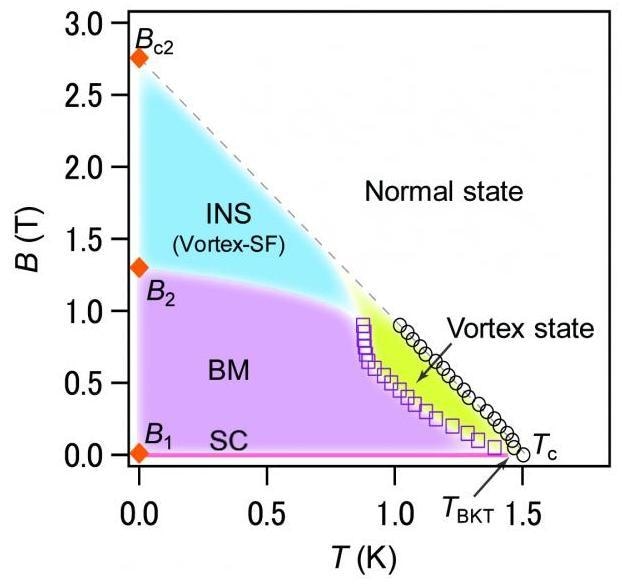Jun 28 2019
Traditionally, it was considered that when sufficiently large magnetic fields were applied, it leads to the interruption of superconducting states in materials even at dramatically low temperature, thus altering them directly into insulators.
 This is a schematically drawn phase diagram of superconductivity-related states in ultrathin NbSe2. SC: superconductor; BM: Bose metal; INS: insulator; B1, B2, Bc2: magnetic fields at boundaries between the phases.
This is a schematically drawn phase diagram of superconductivity-related states in ultrathin NbSe2. SC: superconductor; BM: Bose metal; INS: insulator; B1, B2, Bc2: magnetic fields at boundaries between the phases.
Currently, researchers from Tokyo Institute of Technology (Tokyo Tech), The University of Tokyo, and Tohoku University have reported peculiar multi-state transitions of these superconductors: transitioning from superconductor to special metal and subsequently to insulator.
Superconductors are characterized by their zero electrical resistance or otherwise their potential to fully expel external magnetic fields. They also have attractive prospects not just for fundamental physics but also for applications such as superconducting coils for magnets.
This phenomenon can be perceived by taking into account a highly ordered relationship between the system’s electrons. As a result of the coherence over the complete system, electrons make bounded pairs and flow without collisions, as a whole, leading to an ideal conducting state without any dissipation in energy.
However, when a magnetic field is introduced, the electrons can no more maintain their coherent relationship and thus the superconductivity is lost. For a specified temperature, the highest magnetic field under which a material retains its superconductivity is called the critical field.
Usually, these critical points are characterized by phase transitions. If the shift is sudden as in the case of melting of ice, it is a first-order transition. In case the transition occurs in a continuous and gradual way by the increase in change-driving fluctuations extending on the whole system, it is known as a second-order transition.
Analyzing the transition path of superconductors upon being subjected to the critical field can offer insights about the quantum processes involved and enables designing smarter superconductors (SCs) for use in sophisticated technologies.
An interesting fact is that 2D superconductors (2DSCs) are the ideal candidates for analyzing this kind of phase transitions and one such innovative candidate is a mono-unit layer of NbSe2. Since smaller dimension (thickness) of superconductor signifies a smaller number of probable partners for electrons to form superconducting pairs, it is feasible for the smallest perturbation to set a phase transition. Moreover, 2DSC is applicable to small-scale electronics applications.
Increasing the applied magnetic field higher than a critical value in such materials results in a fuzzy state where the magnetic field penetrates the material, yet the resistance is still very less. It is only upon raising the magnetic field further that the superconductivity is lost. The material turns into an ordinary insulator.
This is known as the superconductor-to-insulator phase transition. Since this phenomenon is seen at extremely low temperatures, the quantum fluctuations in the system turn out to be comparable to or even more than the classical thermal fluctuations. Hence, this is known as a quantum phase transition.
In order to gain insights into the phase transition path as well as the mixed or fuzzy state that occurs between the critical field strengths in the NbSe2 ultrathin superconductor, a research team measured the magnetoresistance of the material, or the response of the resistivity of a superconductor upon being subjected to external magnetic field.
Using a four-point probe, we estimated the critical magnetic field at the respective quantum phase boundaries in the mono-layered NbSe2.
Prof. Ichinokura, Study Lead Author, Tokyo Institute of Technology
It was observed that upon applying a small magnetic field to the SC, the coherent flow of electrons is paused, but the electron pairs still remain. This is caused by the motion of vortices; the moving vortices develop a finite resistance. The origin of this minimal resistance was found out to be the state at which the material enters a unique metal state, known as the Bose metal (BM), which transformed into an insulating state when the magnetic field was further increased.
The researchers also discovered that the transition between SC and normal states close to the critical temperature was induced by quantum fluctuations while also reflecting an analogous multi-transition pathway. Prof. Ichinokura was excited by the outcomes and commented that “The scaling analysis based on the model of the Bose metal explained the two-step transition, suggesting the existence of a bosonic ground state.”
This research supports the theoretical hypotheses of multi-phase transitions in superconductors, with the help of the thinnest sample of atomic-scale thickness, and pushes the boundary of study further. The transition path was the result of studying the fluctuating vortices this time; what will be the result of investigating the vortex from here? Only science can answer this question!